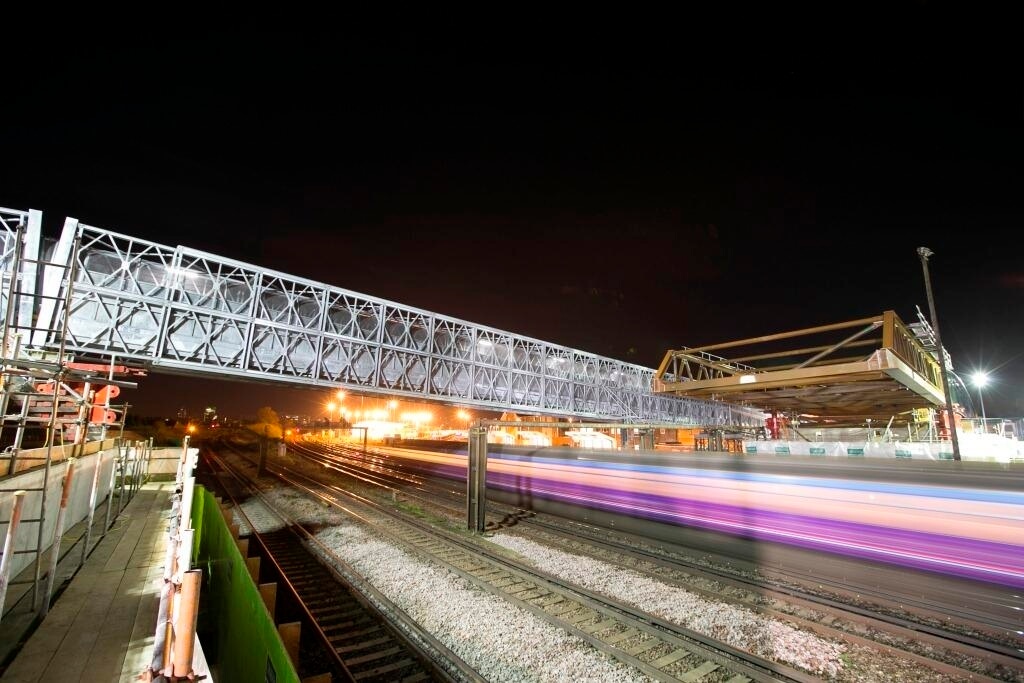This Rail Week – an industry-wide effort to inspire future rail workers – we’re sharing the excitement of all things science, technology, engineering and maths (STEM).
We’re always exploring new technology to make the network better and more reliable for passengers and freight operators. In fact, we’ve just a multi-million-pound investment to work with universities to improve research and development.
Innovation helps us work more safely and efficiently, leading to better outcomes.
Here are five times tech has changed the way we work:
1. ElevArch jacking technique
The Rail Safety and Standards Board (RSSB) teamed up with Network Rail and the Department for Transport to try to find ways to avoid reconstructing bridges during electrification projects.
Overhead line equipment has to be installed to electrify the railway. This usually means there needs to be a greater distance between the railway and any bridges above, so the overhead equipment fits beneath the bridge. Typically, the methods to create this extra headroom are either lowering the track or demolishing the bridge arch and replacing it with a precast concrete unit.
Where possible, we avoid reconstructing bridges because it’s usually the most expensive option and can disrupt the road and rail network. It can be the best choice if a bridge is in poor condition but technical alternatives can provide solutions that avoid this costly reconstruction.
One of the proposals that made it to this final stage of our collaboration with RSSB was from Freyssinet and Bill Harvey Associates, which developed the bridge-jacking solution ElevArch. It now has UK and international patents and has won numerous industry awards.
2. Seventy-thousand images a second!
We’ve bolstered our ability to reduce delays caused by track faults, improving safety and saving the taxpayer millions of pounds.
In January, we opened a second Plain Line Pattern Recognition (PLPR) facility in Derby to increases our capacity to monitor, inspect and fix track faults:
PLPR is an important part of our ‘predict and prevent’ strategy. It’s state-of-the-art technology that monitors and records track condition information, and can find issues such as missing fasteners, excess ballast and ineffective rail clamps.
A fleet of five monitoring trains, including the New Measurement Train (NMT) – the most technically advanced train of its type in the world – uses it.
Cameras mounted underneath the trains capture an image every 0.8mm, taking 70,000 images a second at the top speed of 125mph.
PLPR identifies potential defects and sends them to our expert inspection team in Derby. Local track section managers then receive information about confirmed defects, enabling engineers to target track maintenance more effectively.
3. Virtual reality
Our huge upgrade of Liverpool Lime Street station, which officially completed a year ago, used virtual reality to carry out 4D modelling during preparations for the work – an emerging but hugely progressive technology application for the railway.
This reduced the amount of time needed on track and the potential to impact on train services. It also allowed planners to avoid overlaps between different engineering teams and identify potential risks and hazards that could have potentially affected the railway’s reopening.
Virtual reality images of the improvements at Liverpool Lime Street based on data from the site:
4. Game-changing automated design
This spring, we identified state-of-the art automated design that’s set to dramatically change the way we build and maintain Britain’s railway.
The technology, which we aim to implement at Network Rail for the first time next year, has the potential to shorten the amount of time it takes to design a route or piece of infrastructure from several months to just several days.
This will help us deliver new projects, repairs and upgrades to passengers much faster. We will also save substantial sums of money and maximise value for the taxpayer.
How? This tool will automatically design elements of the railway such as track, power supply, signalling systems and bridges. It will do this by bringing together various sources of data railway design teams use and run through all the possible outcomes to find the safest and most efficient design.
5. Traffic management tech reduces delays
Also in the spring, passengers in Wales benefitted from one of our first digital railway initiatives. A traffic management system launched in south Wales to help operators manage the timetable – reducing delays for passengers and freight operators
The Thales ARAMIS system helps more than 300 trains a day. It provides real-time enhanced data to operators, flags potential conflicts and helps train running controllers proactively manage services.
It minimises the knock-on delays that can cause widespread disruption after an incident and allows real time re-planning so services can quickly return to normal.
It’s part of our Digital Railway strategy to use technology to help provide better and more journeys as demand for train services continues to rise:
Read more:
Research, development and technology




